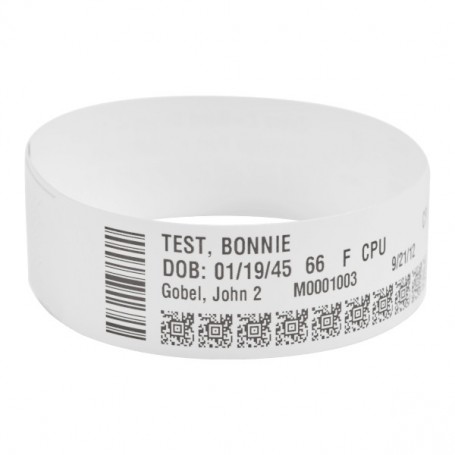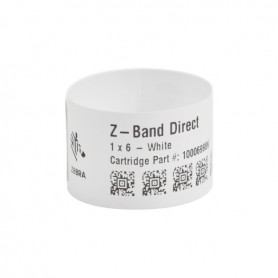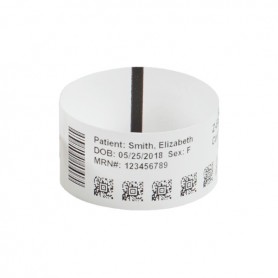Zebra Z-Band Direct adult bands white 25 mm x 279 mm
Wristbands for adults white Zebra Z-Band Direct
- Durable clasp, glued with high-strength acrylic
- Bands coated with white polypropylene film for thermal printing
- Antibacterial coating
- Printing resistant to smearing, abrasion, water, alcohol, blood, mild cleaning agents, etc.
- Number per roll – 200 pcs.
- Number of rolls in the package – 6
- Band size – 25 x 279mm
Zebra Z-Band Direct wristbands for adults
Wristbands for adults in white, thermal, polypropylene in cartridge Adhesive clasp with strong acrylic glue. Material coated with white polypropylene film for thermal printing with antibacterial coating. Adhesive tip with high-strength acrylic adhesive. The printed text on the bands is resistant to smearing, abrasion and water, alcohol, mild cleaners, blood, etc.
In order to be able to treat patients effectively, transparency in the classification and recording of patients must be ensured. Manually writing data on patient wristbands is inefficient and can lead to mistakes. In extreme cases even to confuse two patients. This, in turn, can lead to the patient being given the wrong dose of the drug or a completely different remedy, which is unacceptable.
Z-Band Direct wristbands offer ease of use and effectiveness in recording. Classic wristbands have only a text window, while those offered by Zebra Technologies are suitable for printing on their entire surface. Printed content is much more readable than handwritten content, and in addition to the text itself, the use of bar codes and QR codes can be implemented into the system. Thanks to this, it is possible to contain more information on the surface of the band. The use of strong acrylic glue ensures ease and speed of putting on, and the polypropylene film protects against accidental breaking of the band. The same film allows the use of thermal printing, which does not require the use of ribbons. In turn, the antibacterial coating protects against settling and the development of bacteria, including Staphylococcus aureus, which are among the common causes of infection in hospitals. The bands are separated by a perforation, so they can be easily downloaded from the printer without damaging the next piece. The product does not contain latex.
In addition to being used in healthcare, Z-Band Direct wristbands will work, for example, as an identifier for ticketed events, or as passes to separate and VIP zones.
|
Technical specifications of Wristbands Zebra Z-Band Direct for children
|
|||||||||||||||||||||||||||||
Wristbands Zebra Z-Band for leading durability and readability for the scanner
Consistently outstanding quality
An unreadable barcode threatens patient safety and staff productivity. For this reason, we design, manufacture and rigorously test our own line of Z-Band thermal printing bands. They ensure optimal image durability
and scanning performance – guarantee reliable reading of even narrow barcodes the first time.
Up to six times more durable than other wristbands
The barcodes on the Z-Band have been tested for resistance to water, soap, foams, alcohol and other solvents commonly used in healthcare facilities. Independent laboratory tests have shown that Z-Band bands are
two to six times more durable than the wristbands of leading competing brands with repeated exposure to commonly used hand sanitizers. 1 You can be sure that the barcodes on the Z-Band will remain readable by the scanner for longer than the patient's average stay in the facility – so nurses won't have to look for a way to solve the unreadable code or reprint the faded wristband.
Wide range of colours and sizes for wristbands
The ZD510-HC Zebra supports Zebra's full range of white and color Z-Band wristbands. Z-Band bands are available in a range of sizes (from infant to adult), with an adhesive clasp or with a latch. Z-Band wristbands are resistant to hand sanitizers and do not irritate the skin. And by using Z-Band UltraSoft wristbands, one of the softest wristbands on the market, you can provide comfort to patients with even the most sensitive skin.
Z-Band wristbands have been found safe in an MRI environment and do not appear to pose an additional risk to patients undergoing MRI procedures.










